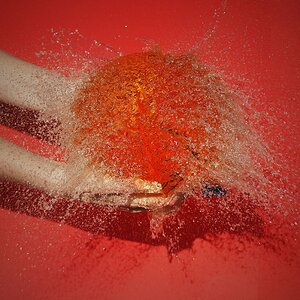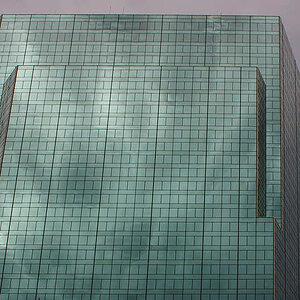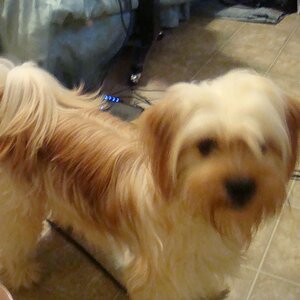So I've been reading Ansel Adams book 'the camera' and on the lenses chapter, it says if you increase subject distance by X the depth of field increases by X^2. Just wondering why that is and if anyone has a better explanation as to how depth of field works. Thanks
Navigation
Install the app
How to install the app on iOS
Follow along with the video below to see how to install our site as a web app on your home screen.

Note: This feature currently requires accessing the site using the built-in Safari browser.
More options
You are using an out of date browser. It may not display this or other websites correctly.
You should upgrade or use an alternative browser.
You should upgrade or use an alternative browser.
why does depth of field increase as subject distance increases
- Thread starter jarg007
- Start date
- Joined
- May 1, 2008
- Messages
- 25,422
- Reaction score
- 5,003
- Location
- UK - England
- Website
- www.deviantart.com
- Can others edit my Photos
- Photos OK to edit
I can't say why but if you're asking questions like this you might want to start looking up terms such as "optical physics" because its going to be in physics that you get the most complete answer. Most photographers only know the results; a couple know the theory or parts of it and a very small number know the physics
Well if Just Because isn't a good enough answer you might start here.
Why Does a Small Aperture Increase Depth of Field Physics Soup
Stops Pupils and Apertures
Why Does a Small Aperture Increase Depth of Field Physics Soup
Stops Pupils and Apertures
TCampbell
Been spending a lot of time on here!
- Joined
- Mar 31, 2012
- Messages
- 3,614
- Reaction score
- 1,556
- Location
- Dearborn, MI
- Can others edit my Photos
- Photos OK to edit
I'm going to give you two answers... first the "short" answer:
Think of the difference in distance not as a true difference between two elements of focus, but rather as a percentage change, then it's easier to image.
Suppose you place a subject precisely 10' away from the camera and find that the distance from the camera to the tip of your subject's nose is precisely 10' 0". Suppose their nose is only 1" in front of their face so that means their cheeks are 10' 1" away.
When you think of this difference as a percentage you get 10' (which is 120") vs. 10' 1" (which is 121"). The difference between 120 and 121 is less than 1% (.008). That's not much.
Now move your subject much closer... put them a mere 1' in front of the camera. Distance to cheek is still a mere 1" farther than distance to nose. So now its 12" (to the nose) vs. 13" (to the cheek). But 12 vs. 13 is a greater difference as a percentage. It's actually a difference of 8% (instead of .8%).
In other words the difference in distance (when thought of as a percentage away from our true focused distance) is actually 10x greater even though the physical difference is still just 1".
Now for the "long" answer:
This would be easier if I had a white board to draw a few pictures... so I'll try to describe it in words as simply as possible.
Suppose we have a single lens element (the piece of glass that we'll take from a magnifying glass). If we identify some point on the lens ... say 10mm above the exact center of the lens... and also the same 10mm below the exact center point of that lens, then the curvature of that lens at that "10mm away from center axis" will be identical (hopefully... otherwise we're not very good at grinding lenses.)
Suppose we state that the curvature of the glass at that point is enough to bend a single ray of light passing through that point... by 30º. So instead of the light passing "straight" through with it's path unaltered... it's bent inward toward the center by 30º (I'm making this number up). That 30º bend for that specific distance from the center (closer to center will bend less... farther from center will bend more) is a constant.
If light originates from a subject (say the very tip of your nose) and you are 10' away from the camera lens, then as the light reflects off your nose, some rays of light will travel exactly to the very center of the lens... some will travel just lightly to the top of the lens. Some will travel to the bottom of the lens (and lots of light will miss the camera lens completely but we don't care about that.) But since the light originated from just ONE point (the very tip of your nose) we need that light to converge back at just ONE point behind the lens (otherwise the image would be blurry).
If we pick just two arbitrary (but symmetric with respect to distance from center) points on the glass... that 10mm above center axis and 10mm below -- both rays need to converge at the same point on the back of the lens (on the camera sensor). And remember... the angle at that 10mm from center point is always precisely 30º (in my example anyway... a different lens of a different size and curvature would have a different value.)
So I can trace an imaginary line from the tip of your nose, to the point which is 10mm above center axis of lens, and then bend the line downward by 30º and draw a line extending back behind the lens. I also need to draw a 2nd line from the tip of your nose to a point which is 10mm below the center axis of the lens, and then bend that line 30º upward as it extends beyond the lens. Those two lines behind the lens... they'll cross each other and form an "X". The intersection of that "X"... that's the focus distance. If the sensor is positioned exactly at that distance then you'll get a focused image.
NEXT... suppose we focus you at just 5' from the lens instead of 10' from the lens.
Keep in mind that the amount of bending that happens at my arbitrarily chosen (but symmetric) points on the lens is precisely 30º (in my example). So if your nose is now closer to the lens, the angle of the two lines that leave your nose and travel to those two points will now be a bigger angle at 5' then it was at 10'. If we increase the angle on the front side of the lens, it means that the point where the lines at the back of lens converge (my "X") is now located farther away from the lens than it was before. I have to move the sensor back to get it to the new location where those lines intersect at my "X". In reality, we just move the lens forward a little. (Use an old prime lens where you can actually see the lens element move.. like a 50mm lens.. and you'll notice that front element on the lens move FORWARD as you focus to SHORTER distances.)
So moving the lens forward or backward, changes the focused distance.
Again... we're just using ONE lens element (in reality there are many), and we're treating all light as though it bends by the same amount when passing through the glass lens (in reality blue bends more than red so the wavelengths of the light are important.) I am, of course, simplifying.
NEXT... hopefully by now you recognize (1) how a single lens element bends light. You also recognize (2) that in order to focus a lens for a subject at different distances in FRONT of the lens means you have to change the distance from lens to focus plane (sensor) BEHIND the lens. Now we can talk about depth of field.
We can think of the light rays traveling in "straight" lines and focusing to a single "point" (again... simplifying because the reality is the light travels as a wave and each frequency of light (color) has a different wavelength. And also this light doesn't technically focus to a single point, it focuses to a shape called an "Airy Disk" but it's not necessary to go to that detail to describe how focus works at this level.)
As we defocus the image, the focus "point" enlarges to something called a "circle of confusion" ("bokeh balls" is an example of defocused circles of confusion. Just go to "images.google.com" and type "bokeh balls" as your search term and you'll see hundreds of examples.)
Any camera and lens combination will have the ability to resolve fine detail down to some level. There are microscopic creates that we can see through microscopes, but our human eyes cannot see them because we can not resolve the detail fine enough (not without the aid of a microscope). Logically... there is some "minimum" size that you can recognize and below that limit you can't distinguish anything.
It turns out this same concept works for focus. Even though the letters on your computer screen might not really be "tack sharp" if you used a microscope to inspect them, your eyes will accept them as "tack sharp" because it lacks the ability to resolve detail sufficiently to realize that they are not truly "tack sharp".
If the tip of your nose is technically closer to the camera than your cheekbone and we precisely focused to the tip of your nose, your eyes will just accept that the skin on your cheeks is also in sharp focus even though it's technically not as sharp as the skin on the tip of your nose. Each point has just fractionally de-focused. But your eye lacks the ability to resolve detail at that level so it still accepts the image as being "focused".
But think about what you know bout lens focus and angles to understand "why" this works... if I draw a triangle from the tip of your nose to the two points located 10mm above and below the center axis of the lens... and you are 10' away... that angle is VERY tiny. If I then draw the same triangle but this time instead of measuring from the tip of your nose -- I measure from your cheeks... that's also a VERY tiny angle. But more importantly... I can barely measure the difference between the angle at the tip of your nose on the first triangle and the angle at the surface of cheeks on the second triangle. And since I can BARELY measure any difference in FRONT of the lens, I also have almost no change BEHIND the lens. So both areas appear to be in more-or-less equal focus.
Now lets change the parameters and move you to a mere 1' in front of the lens. Now if I draw the triangle from your nose to the lens vs. the triangle from your cheek to the lens, the angle is suddenly very measurable AND it's so measurable that I need to move the distance of my sensor BEHIND the lens to compensate.
Long post... I know... and I wish I had pictures (an animation would be even better).
Think of the difference in distance not as a true difference between two elements of focus, but rather as a percentage change, then it's easier to image.
Suppose you place a subject precisely 10' away from the camera and find that the distance from the camera to the tip of your subject's nose is precisely 10' 0". Suppose their nose is only 1" in front of their face so that means their cheeks are 10' 1" away.
When you think of this difference as a percentage you get 10' (which is 120") vs. 10' 1" (which is 121"). The difference between 120 and 121 is less than 1% (.008). That's not much.
Now move your subject much closer... put them a mere 1' in front of the camera. Distance to cheek is still a mere 1" farther than distance to nose. So now its 12" (to the nose) vs. 13" (to the cheek). But 12 vs. 13 is a greater difference as a percentage. It's actually a difference of 8% (instead of .8%).
In other words the difference in distance (when thought of as a percentage away from our true focused distance) is actually 10x greater even though the physical difference is still just 1".
Now for the "long" answer:
This would be easier if I had a white board to draw a few pictures... so I'll try to describe it in words as simply as possible.
Suppose we have a single lens element (the piece of glass that we'll take from a magnifying glass). If we identify some point on the lens ... say 10mm above the exact center of the lens... and also the same 10mm below the exact center point of that lens, then the curvature of that lens at that "10mm away from center axis" will be identical (hopefully... otherwise we're not very good at grinding lenses.)
Suppose we state that the curvature of the glass at that point is enough to bend a single ray of light passing through that point... by 30º. So instead of the light passing "straight" through with it's path unaltered... it's bent inward toward the center by 30º (I'm making this number up). That 30º bend for that specific distance from the center (closer to center will bend less... farther from center will bend more) is a constant.
If light originates from a subject (say the very tip of your nose) and you are 10' away from the camera lens, then as the light reflects off your nose, some rays of light will travel exactly to the very center of the lens... some will travel just lightly to the top of the lens. Some will travel to the bottom of the lens (and lots of light will miss the camera lens completely but we don't care about that.) But since the light originated from just ONE point (the very tip of your nose) we need that light to converge back at just ONE point behind the lens (otherwise the image would be blurry).
If we pick just two arbitrary (but symmetric with respect to distance from center) points on the glass... that 10mm above center axis and 10mm below -- both rays need to converge at the same point on the back of the lens (on the camera sensor). And remember... the angle at that 10mm from center point is always precisely 30º (in my example anyway... a different lens of a different size and curvature would have a different value.)
So I can trace an imaginary line from the tip of your nose, to the point which is 10mm above center axis of lens, and then bend the line downward by 30º and draw a line extending back behind the lens. I also need to draw a 2nd line from the tip of your nose to a point which is 10mm below the center axis of the lens, and then bend that line 30º upward as it extends beyond the lens. Those two lines behind the lens... they'll cross each other and form an "X". The intersection of that "X"... that's the focus distance. If the sensor is positioned exactly at that distance then you'll get a focused image.
NEXT... suppose we focus you at just 5' from the lens instead of 10' from the lens.
Keep in mind that the amount of bending that happens at my arbitrarily chosen (but symmetric) points on the lens is precisely 30º (in my example). So if your nose is now closer to the lens, the angle of the two lines that leave your nose and travel to those two points will now be a bigger angle at 5' then it was at 10'. If we increase the angle on the front side of the lens, it means that the point where the lines at the back of lens converge (my "X") is now located farther away from the lens than it was before. I have to move the sensor back to get it to the new location where those lines intersect at my "X". In reality, we just move the lens forward a little. (Use an old prime lens where you can actually see the lens element move.. like a 50mm lens.. and you'll notice that front element on the lens move FORWARD as you focus to SHORTER distances.)
So moving the lens forward or backward, changes the focused distance.
Again... we're just using ONE lens element (in reality there are many), and we're treating all light as though it bends by the same amount when passing through the glass lens (in reality blue bends more than red so the wavelengths of the light are important.) I am, of course, simplifying.
NEXT... hopefully by now you recognize (1) how a single lens element bends light. You also recognize (2) that in order to focus a lens for a subject at different distances in FRONT of the lens means you have to change the distance from lens to focus plane (sensor) BEHIND the lens. Now we can talk about depth of field.
We can think of the light rays traveling in "straight" lines and focusing to a single "point" (again... simplifying because the reality is the light travels as a wave and each frequency of light (color) has a different wavelength. And also this light doesn't technically focus to a single point, it focuses to a shape called an "Airy Disk" but it's not necessary to go to that detail to describe how focus works at this level.)
As we defocus the image, the focus "point" enlarges to something called a "circle of confusion" ("bokeh balls" is an example of defocused circles of confusion. Just go to "images.google.com" and type "bokeh balls" as your search term and you'll see hundreds of examples.)
Any camera and lens combination will have the ability to resolve fine detail down to some level. There are microscopic creates that we can see through microscopes, but our human eyes cannot see them because we can not resolve the detail fine enough (not without the aid of a microscope). Logically... there is some "minimum" size that you can recognize and below that limit you can't distinguish anything.
It turns out this same concept works for focus. Even though the letters on your computer screen might not really be "tack sharp" if you used a microscope to inspect them, your eyes will accept them as "tack sharp" because it lacks the ability to resolve detail sufficiently to realize that they are not truly "tack sharp".
If the tip of your nose is technically closer to the camera than your cheekbone and we precisely focused to the tip of your nose, your eyes will just accept that the skin on your cheeks is also in sharp focus even though it's technically not as sharp as the skin on the tip of your nose. Each point has just fractionally de-focused. But your eye lacks the ability to resolve detail at that level so it still accepts the image as being "focused".
But think about what you know bout lens focus and angles to understand "why" this works... if I draw a triangle from the tip of your nose to the two points located 10mm above and below the center axis of the lens... and you are 10' away... that angle is VERY tiny. If I then draw the same triangle but this time instead of measuring from the tip of your nose -- I measure from your cheeks... that's also a VERY tiny angle. But more importantly... I can barely measure the difference between the angle at the tip of your nose on the first triangle and the angle at the surface of cheeks on the second triangle. And since I can BARELY measure any difference in FRONT of the lens, I also have almost no change BEHIND the lens. So both areas appear to be in more-or-less equal focus.
Now lets change the parameters and move you to a mere 1' in front of the lens. Now if I draw the triangle from your nose to the lens vs. the triangle from your cheek to the lens, the angle is suddenly very measurable AND it's so measurable that I need to move the distance of my sensor BEHIND the lens to compensate.
Long post... I know... and I wish I had pictures (an animation would be even better).
Similar threads
- Replies
- 17
- Views
- 1K
- Replies
- 42
- Views
- 3K
- Replies
- 6
- Views
- 1K
- Replies
- 8
- Views
- 738










![[No title]](/data/xfmg/thumbnail/42/42054-e8278f89f6a543cad8fd644e37b064f3.jpg?1619739992)

